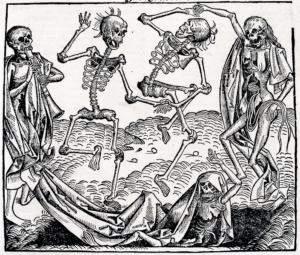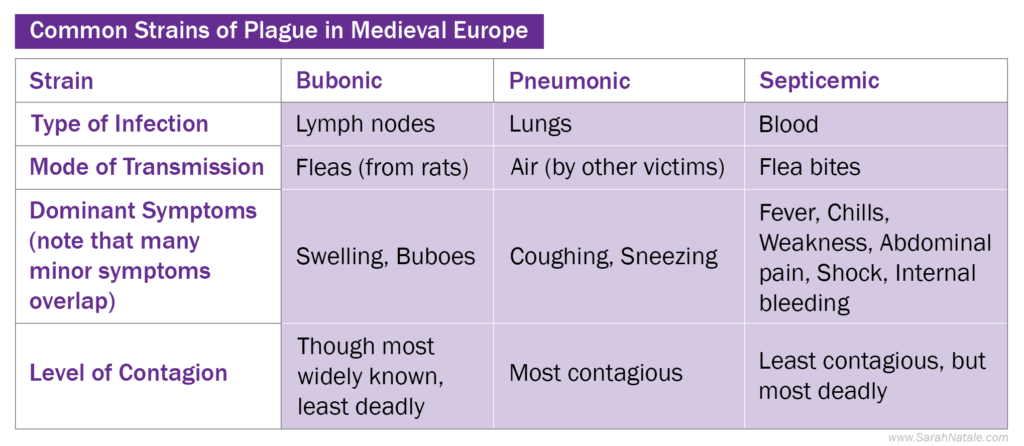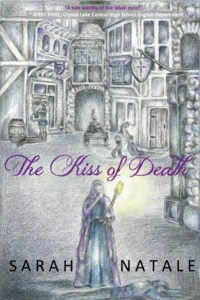My guest author for September on Historical Writers Across Time is Sarah Natale, writing about the 14th-century plague of the Medieval Age, the setting for her novel The Kiss of Death.
 “Rumors spread rapidly as we heard that ours was not the only house afflicted with this fast-moving plague. And a plague it was, for there was no better name for this mysterious disease that seemed to infect everyone it came into contact with.”
“Rumors spread rapidly as we heard that ours was not the only house afflicted with this fast-moving plague. And a plague it was, for there was no better name for this mysterious disease that seemed to infect everyone it came into contact with.”
~ Elizabeth Chauncey, The Kiss of Death, Chapter Three
In the mid-14th century, no one knew where the plague came from, or worse – how it was spread. It was no wonder that it went rampant through the streets of medieval London. Elizabeth Chauncey would not have been the only one baffled by its unseen, ubiquitous movement.
Today, scientists have discovered that the deadly disease was caused by the bacterium Yersinia pestis.

It comes in three forms: bubonic, pneumonic, and septicemic. The bubonic strain mainly infected lymph nodes. This caused swelling and buboes in patients, hence the iconic name “Bubonic” Plague by which it is most known. And, popular lore was right: it was spread by rats – more specifically the fleas that traveled on their backs. Likewise, the pneumonic strain infected the lungs and was spread by the breaths of infected victims. The third and least known form is the septicemic strain. It was contracted from flea bites right into the bloodstream where it wreaked havoc on the patient’s life by inducing fever, chills, weakness, abdominal pain, shock, and internal bleeding.

“In order to maintain your peak health, take these precautions: the disease is sometimes transmitted through air due to the awful smell put out from the dead and dying, so if you must go outside, use a handkerchief to cover your face, and dip it in some aromatic oil. It will do you well.”
~ Physician, The Kiss of Death, Chapter Three
The physician who tends to one of Elizabeth’s family members in The Kiss of Death is not entirely inaccurate when he says that the plague traveled through the air, though it wasn’t the smell that made it deadly. Plague particles did spread through the air, aided by coughing and sneezing of infected victims. It was, in fact, the plague’s most effective highway of transmission, as few people knew what we take for granted as simple disease prevention methods today: covering the mouth whenever one coughs or sneezes.
Some people did cover their mouths as the physician suggested, but most were more concerned with warding off the smell of death and disease than any actual prevention. Incense and smelling scents such as juniper and rosemary were particularly popular forms of masking the scent, though they did little in preventing the disease. It’s a wonder that anyone survived in such a time of poor hygiene at all!
But survive, they did. And now, almost 700 years later, here we are to tell their tale.
—
Author Bio 
Sarah Natale is the author of The Kiss of Death, her medieval historical fiction debut (Kellan Publishing, 2015). Sarah launched her career as a novelist when she signed with a publisher for the book at age 18. She has always had a fascination for the tragedy that devastated one-third of Europe’s population and was excited to craft a story around the historical event in her senior Creative Writing class, where the idea was born. Her story received a fine arts literary award prior to publication. Sarah is a recent Summa Cum Laude graduate of Drake University, where she studied Writing, Public Relations, and Graphic Design. She is from the suburbs of Chicago where she is at work on a sequel and pursuing an additional career as a book publishing professional.
The Kiss of Death Synopsis 
Elizabeth Chauncey is a well-off young woman in 14th century London. Though she is considered nobility due to a distant relative, she refuses to think of herself as such. She is close to a childhood friend, Matthias de Bourgueville, with whom she spends much of her time. They have just returned from an outing at the theatre when her world is shaken up.
Suddenly the servants have taken sick, and soon everyone in London is becoming ill with a mysterious disease. People are dying rapidly and the physicians can do little to halt the spread of disease. Elizabeth and Matthias begin to lose family members, causing a rift in their relationship as love and religion come between them. For what kind of God would inflict such pain and cruelty?
Finally, when her home is bolted shut and she and her sick and dying family are trapped inside a Plague House with no escape, Elizabeth is faced with a choice: remain and die, or flee and take cover in the faith that God will protect her. But time is running out, and she is losing hope. To top things off, Matthias has professed his undying love for her and a proposal of marriage. But if they’re all to die anyway, what is the point of going on?
In short, this is a story of a young woman faced with the pain of loss and decision to stay strong in a world that’s destined to destroy her and everything she loves. It is the tale of looking death in the eye and turning the other cheek. But when faith is lost and death is omnipresent, will she refuse its kiss?

Thank you for featuring me on your September blog, Cynthia! What fun to be part of Historical Writers Across Time 🙂